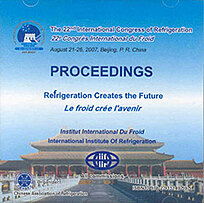
Document IIF
Modélisation et simulation d'un système de cogénération de chauffage et d'énergie résidentiel basé sur une machine à adsorption et une pile à combustible.
Modelling and simulation of a residential CCHP system based on PEM fuel cell and adsorption machine.
Auteurs : SAPIENZA A., CACCIOLA G.
Résumé
Fuel cell and adsorption machine based trigeneration systems are very attractive for residential applications because they allow production of electricity, heat and cold in a decentralized, quiet, efficient and environmentally friendly way. Furthermore, they are suitable to be supplied by methane provided by natural gas city-network. Energy and economic performance of this kind of CCHP (combined production of cold, heat and power) systems depend on the optimization of several design parameters related with the customer's energy demand, the system lay-out, the sizing of components, the control and management strategy. Through a general scheme in which all possible components are included (micro-fuel cell-CHP system, gas boiler, and adsorption heat pump), a mathematical model and a computer simulation tool have been developed in order to calculate the energy balance of the system for a typical energy demand profile for a residential building. Different cases have been considered varying the power-size of each component and comparing the total efficiency with a traditional system based on boiler and electric air conditioner.
Documents disponibles
Format PDF
Pages : ICR07-E2-1586
Disponible
Prix public
20 €
Prix membre*
Gratuit
* meilleur tarif applicable selon le type d'adhésion (voir le détail des avantages des adhésions individuelles et collectives)
Détails
- Titre original : Modelling and simulation of a residential CCHP system based on PEM fuel cell and adsorption machine.
- Identifiant de la fiche : 2008-0970
- Langues : Anglais
- Sujet : Généralités
- Source : ICR 2007. Refrigeration Creates the Future. Proceedings of the 22nd IIR International Congress of Refrigeration.
- Date d'édition : 21/08/2007
Liens
Voir d'autres communications du même compte rendu (839)
Voir le compte rendu de la conférence
-
Residential cogeneration using fuel cells.
- Auteurs : TACCANI R.
- Date : 06/05/2000
- Langues : Slovène
Voir la fiche
-
Performance analysis of a micro-combined coolin...
- Auteurs : DENG J., WANG R. Z., WU J. Y., et al.
- Date : 21/08/2007
- Langues : Anglais
- Source : ICR 2007. Refrigeration Creates the Future. Proceedings of the 22nd IIR International Congress of Refrigeration.
- Formats : PDF
Voir la fiche
-
Solutions pour l'alimentation en énergie d'une ...
- Auteurs : BIANCHI A. M., CIOBÁNAS A.
- Date : 28/11/2001
- Langues : Français
- Source : Eficienta, confort, conservarea energiei si protectia mediului. Volumul 1. Termodinamica si transfer de caldura. Conferinta a VIII-a, cu participare internationala.
Voir la fiche
-
Cogeneration power and cooling for the US army ...
- Auteurs : PATIL A. S., CALKINS F., SIFER N.
- Date : 01/08/2004
- Langues : Anglais
- Source : Natural Working Fluids 2004: 6th IIR-Gustav Lorentzen Conference
- Formats : PDF
Voir la fiche
-
Status of fuel cell system for combined heat an...
- Auteurs : ELLIS M. W., GUNES M. B.
- Date : 12/01/2002
- Langues : Anglais
- Source : ASHRAE Transactions. 2002 Winter Meeting, Atlantic City, New Jersey. Volume 108, part 1 + CD-ROM.
Voir la fiche
